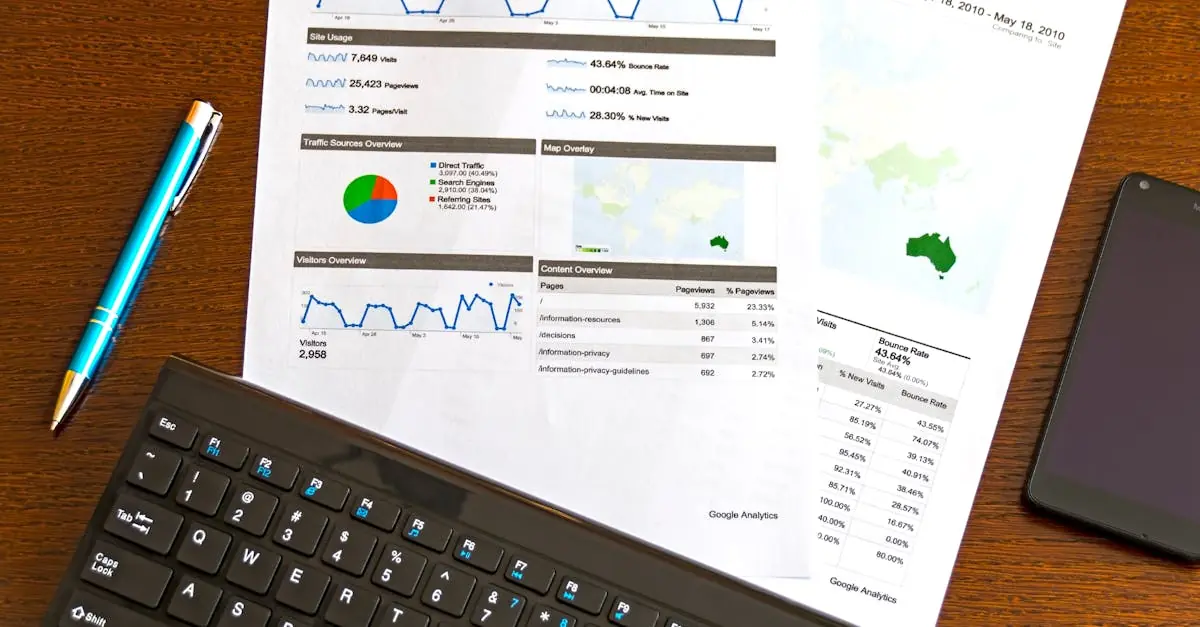Table of Contents
ToggleDividends can feel like the mysterious uncle of investing—everyone talks about them, but few really understand how they work. When it comes to brokerage dividend insights, investors often find themselves scratching their heads, wondering if they’re missing out on a golden opportunity or just chasing their tails. Fear not! This article dives deep into the world of dividends, demystifying the jargon and shedding light on the strategies that can turn those elusive payments into a reliable income stream.
Whether you’re a seasoned investor or just dipping your toes into the stock market, understanding dividends is crucial. They’re not just a bonus; they’re a vital part of a smart investment strategy. So grab your favorite beverage, sit back, and let’s unravel the secrets behind brokerage dividends. Who knows? You might just discover a new way to make your money work for you—without having to don a superhero cape.
Overview of Brokerage Dividend Insights
Brokerage dividend insights provide investors with crucial information about earning potential through dividends. Understanding these insights helps identify opportunities within dividend-paying stocks. Knowledge of dividend yields and payout ratios influences investment decisions significantly.
Several factors determine a brokerage’s dividend offerings. Company profitability stands as a primary indicator. Strong earnings usually result in higher dividends being distributed to shareholders. Additionally, companies with consistent cash flow tend to maintain steady dividend payments, making them attractive to investors seeking passive income.
Performance history remains essential when evaluating dividend stocks. Historical dividend growth reflects a company’s commitment to returning value to shareholders. Analyzing trends over multiple years offers insights into the sustainability of dividends. Furthermore, dividend aristocrats—companies that have increased dividends for 25 consecutive years or more—may represent lower-risk options for income-focused investors.
Investor considerations also include market conditions affecting dividend payouts. Economic downturns can lead to reduced or suspended dividends. A thorough understanding of external factors, such as interest rates, can provide context for dividend investment strategies.
Customized brokerage reports often include detailed analyses of dividend stocks. These reports contain specific forecasts and highlight potential risks associated with dividend investment. Utilizing this information enables better-informed decisions tailored to individual investment goals.
Overall, effectively leveraging brokerage dividend insights can enhance an investor’s portfolio. By focusing on reliable metrics and market trends, they position themselves for long-term income generation through dividends.
Importance of Dividends in Investing
Dividends represent a crucial element in the investing world. They provide investors with a steady income stream, which can enhance overall investment returns.
Understanding Dividends
Dividends are distributions of a portion of a company’s earnings to shareholders. They typically come in the form of cash or additional shares. Companies often pay dividends to reward investors for their support, showcasing their profitability and financial health. The dividend yield, calculated as annual dividends divided by the stock price, helps investors assess the potential income from an investment. Investors should consider dividends as a key factor when evaluating stock options, as they reflect a company’s commitment to returning profits to shareholders and signal financial stability.
Role of Dividends in Portfolio Management
In portfolio management, dividends play a significant role in balancing income and growth. Investors can use dividend-paying stocks to generate passive income, allowing for reinvestment or withdrawal as required. They also help offset market volatility, providing returns even when stock prices fluctuate. Including dividend stocks in a portfolio diversifies income sources, enhancing risk management. Dividend reinvestment plans enable automatic purchase of additional shares, compounding returns over time. Investors seeking stability and lower risk might prioritize dividend stocks, making them pivotal in constructing a robust portfolio designed for long-term financial health.
Key Factors Influencing Brokerage Dividend Insights
Understanding key factors that influence brokerage dividend insights proves essential for investors seeking to enhance income from their portfolios. Two significant aspects are market trends and economic indicators.
Market Trends and Dividend Policies
Market trends significantly shape dividend policies. Companies often adjust their dividend offerings based on shareholder expectations and competitive pressures. For example, sectors such as technology may emphasize growth over dividends, while utilities typically prioritize steady dividend payouts. Observing industry patterns helps investors make informed decisions about firms likely to maintain or increase dividends. Analyzing trends in consumer behavior and market performance can also provide insights into companies’ financial health and dividend sustainability.
Economic Indicators and Their Impact
Economic indicators play a crucial role in determining dividend payouts. A growing economy tends to support rising corporate profits, enabling companies to distribute higher dividends. Conversely, economic downturns often trigger dividend cuts or suspensions, as firms prioritize cash reserves. Investors should monitor key indicators such as GDP growth, unemployment rates, and inflation to assess potential impacts on dividend sustainability. Tracking these metrics allows for a deeper understanding of the economic landscape and its influence on dividend strategies.
Analyzing Brokerage Platforms for Dividend Insights
Brokerage platforms play a significant role in tracking dividends. Investors can leverage various features offered by these platforms to make informed decisions.
Features to Look For
Critical features include clear dividend yields, payout ratios, and historical performance charts. Platforms should provide detailed analyses of dividends, helping investors gauge the sustainability of payouts. Many also offer customizable alerts for dividend announcements. This functionality ensures users remain updated on key changes in dividend policies. Access to research reports enhances understanding of underlying company profitability. Additionally, tools for dividend reinvestment plans compound earnings over time. Prioritizing intuitive interfaces allows for quick navigation through dividend data.
Comparing Major Brokerage Firms
Key brokerage firms vary significantly in their dividend offerings. Charles Schwab, for instance, provides extensive research tools and insights on dividend-paying stocks. Fidelity emphasizes educational resources, making it easier for investors to understand dividend dynamics. E*TRADE stands out with user-friendly platforms and real-time trading features. TD Ameritrade offers robust mobile applications for tracking dividend income on the go. Each firm’s commission structure can also impact overall returns, so investors should analyze fees alongside dividend opportunities. Evaluating these factors aids in selecting the best platform for maximizing dividend investment strategies.
Real-World Examples of Successful Dividend Investing
Investors often find inspiration in successful dividend investment stories. One compelling example is Coca-Cola (KO). This company, a renowned dividend aristocrat, has consistently paid and increased its dividends for over 60 years. The stability in its payout reflects strong brand loyalty and steady cash flow.
Another notable company is Procter & Gamble (PG). This firm has a history of dividend increases dating back to 1957. Their success can be attributed to their diverse product range, which generates consistent revenue even during economic downturns.
Johnson & Johnson (JNJ) also showcases a successful dividend strategy. With a decade-long trend of annual dividend increases, it’s well-regarded for its robust balance sheet and commitment to returning value to shareholders. This reliability attracts long-term investors seeking steady income.
PepsiCo (PEP) complements Coca-Cola’s success during cross-comparison. Similar to its counterpart, PepsiCo has increased dividends for over 48 years. Their global brand presence and extensive distribution networks enable consistent profit generation, allowing reinvestment back into dividend payouts.
3M (MMM) further illustrates the strength of dividend investing. This diversified technology company has raised dividends for over 60 consecutive years. Firms like 3M highlight the importance of innovation and market adaptability in maintaining consistent dividends.
Lastly, AbbVie (ABBV) provides a modern example of successful dividend investing. Despite industry fluctuations, AbbVie has committed to its dividend strategy while pursuing promising drug developments. This balance between innovation and income return emphasizes the versatility of dividend investing.
These examples demonstrate that investing in companies with a strong history of dividend payouts can lead to long-term wealth accumulation. They underscore that both reliability and growth potential matter in constructing a successful dividend-focused investment strategy.
Understanding brokerage dividend insights is essential for any investor looking to enhance their portfolio. By grasping key concepts like dividend yields and payout ratios, investors can make informed decisions that align with their financial goals. The performance history of dividend stocks reveals valuable trends that can guide investment strategies.
Market conditions and economic indicators play a significant role in shaping dividend policies. Thus, staying informed about these factors can help investors navigate potential risks. Leveraging the tools and features offered by various brokerage platforms can further empower investors to optimize their dividend investments.
Ultimately, a well-structured approach to dividends can lead to consistent income and long-term wealth accumulation. By focusing on reliable companies with a strong history of payouts, investors can build a robust dividend-focused strategy that stands the test of time.



